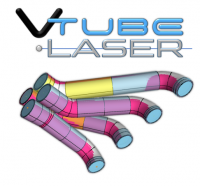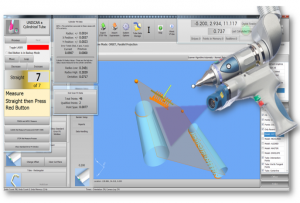How to Diagnose Inaccurate VTube-LASER Measurements
|
When the FARO arm is setup and used properly, the VTube-LASER measurement results should repeat consistently
This is a list of items to check if measurements are not repeating.
How do I know if the data is not repeating?
There will always be variances from measure to measure. Therefore, it is important to establish the line between acceptable and unacceptable variance in measure systems.
Here are two general indicators of repeatability variance:
Indicator 1: Bender Data Adjustment Swings
If you find that the bender adjustment data is showing values that change significantly during repeated measures of the same tube, then system accuracy needs to be addressed. If you find any ANGLE adjustment swing by 2 degrees, then this is probably an indicator of a problem.
Keep in mind that a bend angle of 5 degrees or less can cause the intersection point in that bend to swing more than other parts with other bend angles. This is true for all measuring centers - no matter how accurate they are. Intersecting small angled-bends is challenging mathematically for all systems.
Indicator 2: Linear Distance Deviation Swings
If linear deviations (like tangent point deviations) swing by 0.039, then there may be a problem. The only situation where this is not true would be if the material is very deformed.
Two Kinds of General Issues: Outliers or Inaccuracies
The problem could be either outliers or inaccuracies (or both combined).
Perform this test:
STEP 1 - Scan a cylinder straight. Before calculating the cylinder centerline, release the green button and let the scanned points draw on the screen. Orbit the scanned points.
Do you see any outliers in the VTube viewport when you let go of the green button after scanning? Outliers are points that should not be in the scan. This is a very common issue - especially when using cut planes.
STEP 2 - If there are no outliers, then put the scanner in range of some object and press the red button to calculate the centerline. Examine the wobble deviation by looking at the XY values in the Cylinder fit window.
Do either of the XY values swing widely? The wobble deviation is the higher of either the X or the Y deviation values in the cylinder fit window that pops up during cylinder measurements.
If you see outlier points in the viewport, then...
Even a few outliers can severely impact the calculation of cylinder centerlines. It is important to setup the system to get rid of outliers (for example with the Cut Plane feature.) For example, extra care has to be taken with Newport tables. The outlier issue is NOT a point accuracy issue.
There are two types of outliers:
- Real outliers - These are points scanned from things near the tube.
- Phantom outliers - These are points created in space by overwhelming the camera with feedback that is too powerful. For an example of phantom outlier points, see Scanning on a NEWPORT type table.
There are no outliers present - but there is still a problem, then...
If you see significant changing wobble deviation values without outlier points, then you have eliminated the possibility of outliers, then you should look for other problems that could impact the accuracy of the system.
Look for anything loose in the system that may cause the arm to shift when it is moved
- Is the arm totally secure at the base? Any motion around the base has a strong impact on accuracy.
- Is the probe tightly installed to the arm.
- Is the scanner collar tight?
- Does the tube or table move at all during measurement? If you can see or feel any extra motion at all during measurement, then this will cause problems in repeatability. The entire setup must be absolutely still during measurement. If you can see or feel the environment moving around the arm, then this will always cause problems.
Recalibrate the probe and the scanner
Recalibrate the ball probe then the laser (in that order). If the arm cannot pass calibration of the ball probe or the laser scanner, then you will never get repeatable measurements.
See video 54 in the VTube-LASER Videos page for how to calibrate the probe and scanner.
Is the scanner lens clean and uncovered?
We were setting up for FABTECH and had difficulty scanning a part with an HD scanner. We discovered that the red plastic translucent camera cover was still covering the camera. Any obstruction will ruin the measurement. A dirty lens can impact accuracy.
What scanner algorithm is being used by VTube?
If this is a highly reflective tube, is VTube-LASER setup for automatic HDR mode in the LLP window?
Is the FARO Reflection Filter OFF?
It is best to leave the FARO reflection filter off. Let VTube-LASER handle the laser spikes using its spike filter. See the VTube-LASER Spike Filters page for details.
Is the VTube-LASER Spike Filter Angle Correct?
A laser point on the surface of a diameter that deviates from the surface too far is removed by this filter. The lower the angle, the more strict the filter. See the image at the right. The yellow points deviate too far from the surface path of the laser. For small diameter tubes (0.25" or less), use 30 degrees. For large diameter tubes, using 15 degrees can make the filter require better formed scan lines. See the VTube-LASER Spike Filters page for a detailed description of how VTube uses this angle value.
Is the FARO LLP Scan Density Reduced?
For most tubes, it is best to reduce the scan density to 1/16. This removes points from the incoming line so that only every 16th point remains. The only time you want to set the density higher is when you are scanning very small diameter parts.
Has the external lighting changed?
Is there any new lighting nearby? Is there a bay door open with sunlight flooding in? (This is especially a problem for non-HD scanners.)
Aiming the lens at bright light
If the lens is aimed upward at bright lights or an open door, then this could be the cause of the problem. Try measuring with the scanner lens pointed away from external lights.
Is there a chance that you need the Cut Plane and forgot to measure it?
If you forget to measure a cut plane - but need it, then the VTube math engine will be given outlier points. (They will show in the viewport when you pause scanning.)
Does scanning seem unusually slow?
If scanning seems unusually slow, and the LLP scan density is already set to 1/16, then you should not trust the accuracy of the incoming data. This could be an issue with the FARO USB driver that needs to be restarted. The easiest way to clear driver issues is to shutdown and restart both the VTube-LASER Windows system and the arm.
Does the cylinder have deformations?
VTube always attempts to reduce a cylinder to a single centerline. The centerline is an average fit of all the points taken during cylinder measurement.
If cylinders have bumps, dents, scratches, crushes, then this can severely impact repeatability of the fit to a centerline.
If this is the case, then:
- Try to skip the area that is deformed when scanning.
- If the entire straight is deformed, then increase the number of stripes that VTube-LASER takes in the straight. Make the stripes closer together. Use the wide scan technique. See video 32 for wide scanning: VTube-LASER Videos
- Determine to approach a deformed tube from the same angle every time you measure it. This will reduce variations.
For end lengths that are not repeating...
These issues can impact the accuracy of end lengths too. See End-Scan Technique Research for help on the best end-scan techniques.
Other Pages
- Back to the VTube-STEP page
- Back to the VTube-LASER page




